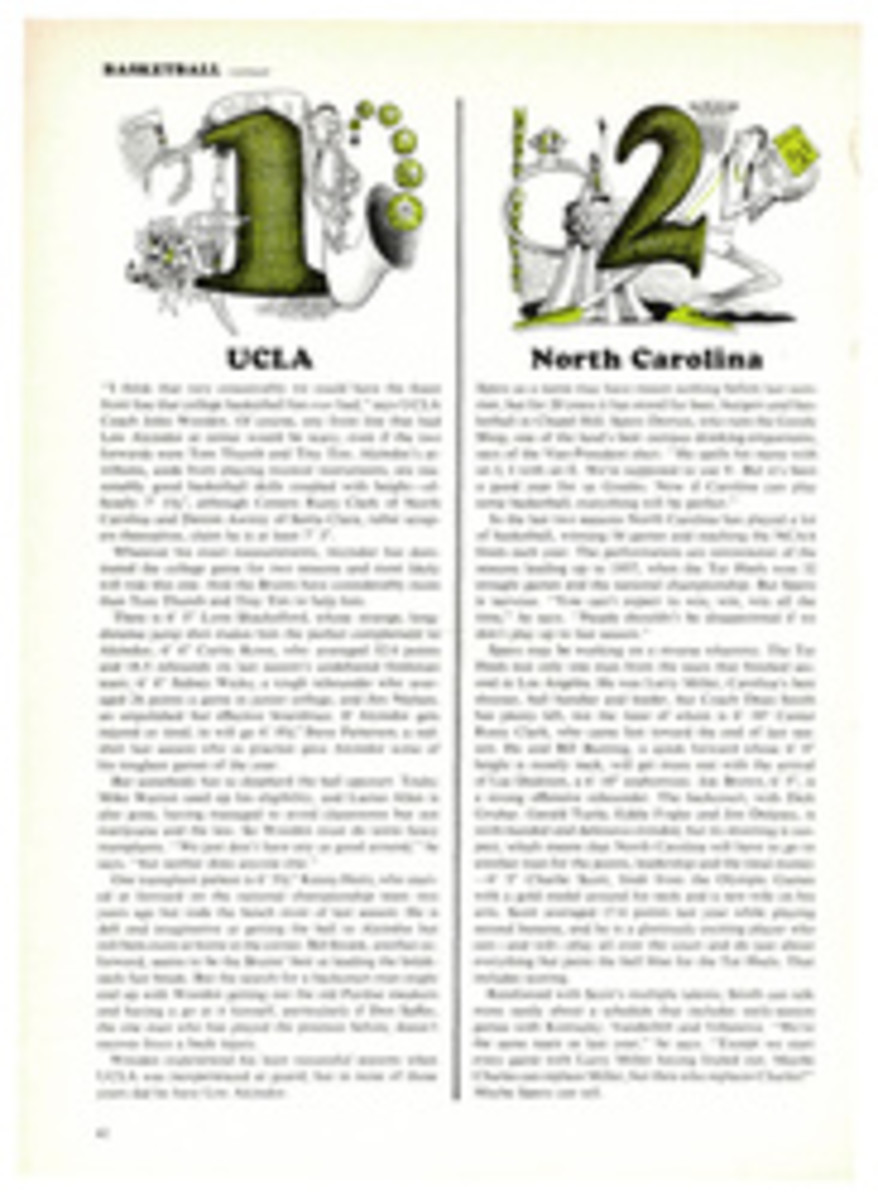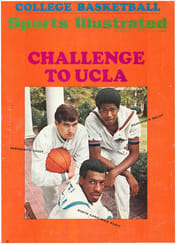
I hear that Arnie shot a 71.4
Years ago the only sport a statistics nut could really get his teeth into was baseball. Then football took to keeping track of things like pass interceptions inside the 23-yard line on rainy days, and basketball began counting left-handed rebounds and technical fouls called on mouthy coaches. Other sports followed—the world was expanding—and now, finally, golf has entered the arena. For the past couple of years IBM has been hauling its 1130 computer around to various courses on the pro tour and recording practically everything that happens in a tournament except melting ice cubes and muttered curses.
This means that golf has suddenly taken on a new glamour for me. I am an antique golf fan, one who relates all 72-hole scores to Tony Manero's record-breaking 282 at Baltusrol in the 1936 Open, who still calls a No. 2 wood a brassie and who thinks that 200 yards is a hell of a drive. IBM straightened me out on that last one in a hurry. Its 1968 Cumulative Golf Statistics, covering the play of 124 professionals in 23 selected tournaments during the year (there are more than 40 tournaments during the season, but an 1130 computer has to pick its spots, like an aging pro), shook me up by revealing to my innocent eyes that 123 of the 124 pros averaged 240 yards or better (Bob Verwey was the banjo hitter), that 106 of them averaged 250 plus, that 31 of them averaged 260 plus and that Jack Nicklaus, at 275, wasn't even first. Good lord.
I discovered another general statistic that was complete news to me. I had always assumed that a man shooting a technically perfect round on a standard par-72 course—that is, straight par golf on every hole—would have 36 strokes tee to green and 36 putts, or two putts per hole. But IBM kept track of the average number of putts per round for these superb golfers, and it isn't anything close to 36 putts. It ranges from 29.5 to 32 a round, which means that the worst putter among the touring pros was four under regulation on the greens. This means that if a pro could shoot 36 from tee to green—that is, play par golf, which seems reasonable—he would average no worse than 68 strokes a round. But only one of the 124 pros—Billy Casper—was able to shoot a sub-70 average. A little scrounging around among the figures brought out the startling fact that the pros do not shoot par golf on the fairway, and they don't come close. Only four made it from tee to green in less than 40, and 70% of them took at least 41 strokes, which is five over the theoretical par. In sum the average par round by a topflight pro is not 36 and 36 but something more like 41 tee to green and 31 putts.
This efficiency on the greens would seem to prove the contention that putting is every bit as important a factor in winning as everyone thinks. But, if putting is where some people win, it also seems to be where others lose. Take George Knudson, for example. Knudson is a superb golfer—until he reaches the green. His drives average 252 yards, farther by a yard than Casper and Julius Boros, and he is more accurate off the tee than either of those sharpshooters. In fact, he is second in accuracy among the 124 on IBM's list. Knudson is also a bear at going on from his drive to the green: only Jack Nicklaus reached the green in regulation more frequently (75.6% of the time to Knudson's 75.0%) and only Nicklaus got there in fewer strokes (39.3 to Knudson's 39.7). In other words, when George Knudson walked onto the green he was second only to Nicklaus and ahead of Billy Casper, Gary Player, Julius Boros, Arnold Palmer—everybody. When he walked off the green he was 27th. He averaged 31.6 putts a round; only four golfers had more. He was 98th in "average putts on greens hit in regulation." In getting down in fewer than two putts, he was 120th. In avoiding three-putt greens, he was 108th. But don't feel too sorry for George. He won the Phoenix and Tucson Opens back to back and earned $71,000 on the tour this year. Just think what would happen if he could putt.
Ron Cerrudo dies on the green, too. Cerrudo, who won the Cajun Classic last weekend, ranked seventh from tee to green in 1968, his second year on the tour, right up there in a tie with people like Boros and Player. But he putted as though Knudson had taught him, and his average of 31.2 putts around—114th best—dragged him from seventh place down to 31st in the ranking for average score per round.
The bright side of the statistics belongs to Casper. Like Knudson's, his drives were short (if you can call 251 yards short) but accurate, and he was third behind Nicklaus and Knudson in reaching the green. On the green he was the best. For instance, even with his 39.8 average tee to green, he lost two strokes a tournament to Nicklaus on the fairways. But his putting made up those two strokes and two more besides. He was tied for first in putts on greens hit in regulation and first by a wide margin in fewest three-putt greens (only 1.3 per tournament). He was first by an even greater margin in fewest holes per tournament over par (7.8). Nicklaus led in most holes under par (15.8), but Casper was much better than Jack in what is either a highly significant or glaringly obvious statistic: the number of holes under par compared to the number over par. Only 26 of the 124 golfers were able to average more birdies than bogeys per tournament, and these 26, with two exceptions, were the 26 top-ranking golfers in average scores (the four best in the birdie-bogey relationship were the four best scorers, and in the same order). Casper was way out front. Nicklaus, who was second, birdied two more holes per tournament than Casper but bogeyed three more. This year Casper led in average score per round, and he won six tournaments (no one else won more than two). Billy earned more than $200,000, almost $50,000 ahead of the second-place Nicklaus. Some golfer.
Arnold Palmer played well enough but he was behind the leaders. He was seventh in money earned (he won two tournaments) and he tied for 14th in average score with 71.0, which is pretty good but not vintage Palmer. His drives averaged 259 yards, 16 behind Nicklaus, and he was in the fairway more often. It is generally assumed that Palmer has lost ground to Nicklaus because of his putting, and that may well be true on the course, but the statistics show that Arnie and Jack averaged precisely the same number of putts per round in 1968—and their other putting figures are about even. The key difference between them seems to be from tee to green. Nicklaus got there in 39.3, nine-tenths of a stroke better than Palmer's 40.2, and in their average scores for 18 holes Nicklaus had the same nine-tenths of a stroke advantage: 70.1 to 71.0. Another set of figures might pinpoint the difference. Palmer had 72.2% of his drives in the fairway, and he reached the green in regulation the exact same 72.2% of the time. Nicklaus, on the other hand, was in the fairway only 67.1% of the time (which indicates that he was in the rough on about four more holes per tournament than Arnie) but even so he got to the greens in regulation 75.6% of the time, which is better than Palmer. Does this mean that Nicklaus can handle the rough better than Palmer can?
One last thing shone out from the IBM figures. Bob Verwey was first in accuracy off the tee (80.0%) but a woeful last in distance (230 yards). Dewitt Weaver was first off the tee (276 yards) but a terrible 113th in accuracy (59.4%). Weaver, chasing those booming, wandering drives, was 121st (fourth from last) in getting to the green, while Verwey, slowly plodding down the middle of the fairway, was 119th (sixth from last). They averaged the same number of putts on greens hit in regulation. All I can think of is, what a pairing these two would make.
In fact, there are three matches I would love to watch: Verwey-Weaver, Knudson-Cerrudo and Nicklaus-Casper. They'd make me forget I ever heard of Tony Manero.

